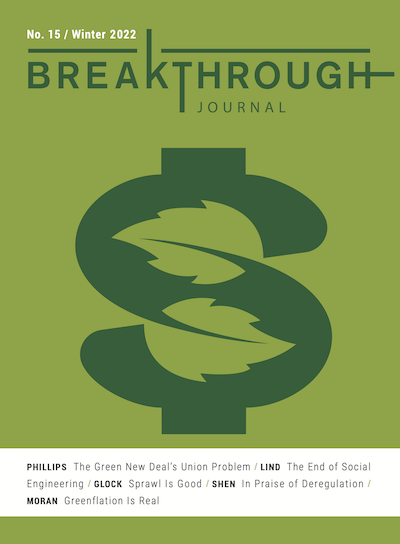After the Green New Deal
Introducing Issue 15 of the Breakthrough Journal
-
-
Share
-
Share via Twitter -
Share via Facebook -
Share via Email
-
Not so long ago, climate activists were dreaming of a transformative Green New Deal—a massive outlay of government investment that would suck carbon out of the economy; build the infrastructure of a new, green America; and create millions of good jobs. Hazy imaginings became more defined as Representative Alexandria Ocasio-Cortez and Senator Ed Markey released their draft version of a deal in 2019 and as President Joe Biden, vowing to place climate at the center of his presidency, adopted elements of their vision into his own $5.5 trillion spending proposal upon taking office.
Fast-forward to now, when many of the green elements of Biden’s original infrastructure plan have been relegated to a separate bill—the roughly $1.75 trillion Build Back Better initiative, whose future is as yet unclear—and others have been axed entirely. As I write, more of the Build Back Better spending could be dedicated to a five-year repeal of the SALT cap ($475 billion)—in effect, a tax cut for high-income households—than to clean energy tax credits ($320 billion) or other climate initiatives ($235 billion), according to calculations from the White House and the Committee for a Responsible Federal Budget.
So what happened? There are many answers, from partisanship; to an everythingism that lumped together environmental, social, and infrastructure concerns; to compromises that resulted in a deal that could win support but not excitement. In other words: politics as usual. But on a deeper level, the legislation, meant to address two of the most important challenges the United States faces—one, reviving the country’s infrastructure and the fortunes of its workers, and two, addressing climate change—may have just gotten climate policy and the politics that surround it all wrong.
At least that is an argument that winds through the articles collected for this issue, starting with author Leigh Phillips’s searing look at the Green New Deal’s labor problem. The proposal may have been conceived as a modern version of the Rooseveltian policies that first won organized labor over to the Democratic Party, Phillips writes in “Blue Collars, Green Jobs?”. But it and subsequent efforts have faced significant criticism from trade unions, who have dismissed elements of the plans as happy talk. While sections of the right have interpreted the pushback as signaling the disintegration of the left, parts of the left have dismissed union voices as obsolete.
Instead, Phillips writes, the climate left should recognize an opportunity: nascent ecomodernism on the part of labor, which demands technological climate solutions, including nuclear; has more knowledge of how energy and infrastructure systems work in practice than any other group; prefers an engineering-based approach; and demands a focus on protecting energy sector workers’ wages, working conditions, pensions, and benefits. “What such examples suggest,” Phillips points out, “is that many on the climate left have got things the wrong way round when they ask: ‘What will it take to win labor to better climate policies?’ Labor already has solid climate policies. What will it take instead for the climate left to understand that?”
In “Civil Engineering, Yes; Social Engineering, No,” Michael Lind, professor and author, most recently, of The New Class War, also sees a blind spot in the development of the Green New Deal. While it is true that the United States needs both investment in infrastructure and a strategy for mitigating and adapting to climate change, combining the two has done a disservice to both. In their zeal for green infrastructure planning, he writes, progressive technocrats have turned matters of taste—“ideal neighborhoods, ideal transit systems, ideal landscape uses, and, more recently, ideal energy systems”—into matters of morality, coming to solutions that are neither good for the economy nor the people upon whom their plans are enacted. Far more productive, he argues, would be to solve the challenges separately, starting by understanding the United States’ true infrastructure needs given its economic goals—maintaining its great-power status and exporting more to global markets—while maintaining a technology-neutral stance to climate mitigation.
Tugging further on Lind’s thread of technocratic solutions gone awry, Judge Glock, senior director of policy and research at the Cicero Institute, takes aim at one of environmentalists’ most sacred truths: that dense cities are key to avoiding catastrophe. In fact, he argues in “Sprawl Is Good,” “sprawling cities are more environmentally sound than their dense counterparts and will become even more so as technology evolves.” Not only are packed cities more dangerous for their residents—air pollution causes more harm in dense cities than in sprawling ones, while rises in temperature are more extreme there, too—they’re not necessarily good for the environment, since building high-rises can be more energy intensive than building single-family homes. Meanwhile, efficiency improvements in automobiles have removed one bugbear for green activists—car emissions. More than the Manhattans of the world, he writes, it is the Atlantas, Nashvilles, and Columbuses that represent a more environmentally sound and economically affordable future.
In “Deregulation Is Not the Enemy,” University of Virginia Assistant Professor Shiran Victoria Shen takes on another conviction among some environmentalists—that deregulation is bad. Whereas neoliberal economists had decided by the 1990s that slaying the regulatory state was the key to unlocking competition and stalled economies, environmentalists pinned vast harm on deregulatory processes and argued for more regulation to control emissions, pollution, and resource use. Those ideas have stuck around, as evident in Biden’s promises to reinstate scores of environmental regulations canceled by his predecessor. Environmental champions have cheered him on while the pro-business crowd has booed, but as Shen sees it, they both have the trade-off wrong. The results of deregulating the power sectors in the United States and China show that, if steered in the right direction, the process can be good for the economy and good for the environment, and make for good politics, too.
Another inconvenient truth: At a time when anxieties over rising inflation are coming to dominate the political conversation, green inflation may well be real. In “Greenflation Is Real,” analyst Michael Moran looks at the environmental, social, and governance movement for socially responsible investing. He explains that, for its proponents, ESG metrics are a way to harness the market in pursuit of sustainability. But for skeptics, “focusing corporate leadership and investor sentiment on such ‘non-material’ indicators will raise the cost of everything a company does, which in turn will be passed on to consumers in the form of higher prices for heating a home, buying a down vest, or filling a weekly grocery basket.” Some have dismissed green inflation concerns as political. But environmentalist groups do so at their own peril—and the environment’s as well.
The environmental movement must also be wary of the politics around meat. An early draft of the Green New Deal hinted that Americans would need to limit their beef consumption, provoking an immediate backlash, Breakthrough’s Alex Smith explains in “The Coming ‘Meat Vortex’.” Meat production is a huge environmental problem, yet animal protein is unshakably popular, which has kept the meat industry too powerful to pressure. Meat, in short, has been politically untouchable. But there are lessons, Smith shows, from other climate successes. “The United States needs to replicate, for meat, the politics that have allowed clean energy to get cheaper and opened political space for further innovation.” In short, it needs a “meat vortex” that could make more environmentally friendly meat alternatives cheaper, tastier, and more attractive than the animal kind.
Fixing beef could be a major climate boon, and not just in the United States. Environmentalists have long worried about the added emissions associated with greater meat consumption around the world as more people become wealthy enough to afford it. In “Green Growth Won’t Kill the Planet,” journalist Fred Pearce turns those equations around. “As the old adage has it,” he writes, “you can only manage what you can measure.” And that has long been a problem for ecomodernists; it is relatively easy to assess climate progress, but there hasn’t been a good, universal set of metrics for what a decent standard of living looks like. “Without a working definition,” he argues, “there has also been no clear understanding of what actual trade-offs—or synergies—might be entailed in achieving decent living standards while fixing the climate.” But recently, the Indian-born technologist Narasimha Rao developed a quantifiable definition. His measure leaves more people below the poverty line than previous estimates, but he has also shown that clearing his bar would not pose a threat to the climate. Decency, as Pearce puts it, is not incompatible with sustainability.

Also taking an international perspective in her reporting in “The Blue-Green Dream,” columnist Elisabeth Braw finds many of the forces discussed in this issue already at work in the real world. In Copenhagen, after devastating flooding, city planners knew they had to do something to prepare the city for more frequent deluges. But they also knew that functional solutions wouldn’t be enough. Climate change mitigation would have to be appealing to taxpaying residents, too. And so, rather than concrete, they opted for new green-blue construction, focused around parks that could become water basins, elevated walkways, and grassy berms. It was all lovely, but the problem comes, of course, when needed solutions offer no added beauty or convenience to residents. Meanwhile, the experience shows that “even within the Western world, climate change could thus create yet another have-have not divide” if cities less able to afford appealing infrastructure lose high-income workers to cities that already have the money for innovative development. “Residents who can’t leave” will be “left behind with only the most rudimentary, visually unattractive, and less livable solutions.” That may well be a recipe for conflict.
“Environmentalism and war purport to be polar opposites,” notes defense writer Michael Peck in this issue’s review essay. “One focuses on protecting nature, the other often ends up destroying it. But armies of environmentalists armed with lasers and spaceships? Ecology at the point of a sword?” Welcome, he writes in “Environmentalism at Swordpoint,” to Dune, Frank Herbert’s classic 1965 science fiction novel now back in theaters as a Denis Villeneuve production. Many understand the story as a parable of irregular warfare, but it offers a challenge to the ecomodernist as well. Herbert’s classic has remained popular by skirting a common sci-fi trap: technology can’t fix everything. But innate human powers don’t work so well, either.
If this issue sounds like a downer, it isn’t. Rather, in at least one important way, I think it reveals real progress. The challenges addressed here—inflation, economic growth, unions, infrastructure, decent living standards—represent the frictions that arise as work on climate change moves from the theoretical to implementation (a stage of the process underlined by this issue’s two tech talks from Susteara and The Metals Company).
The fact that we are here is a good thing.



